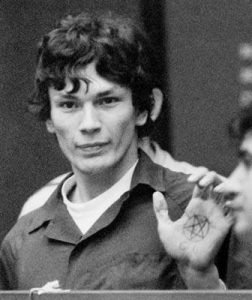“This is a feeling that began for me as long ago as that Friday, August 30, 1985, the night before he was arrested and police broke into the television show I was watching to broadcast his picture. Looking back, I see it was a turning point for me. They showed his mug shot in the middle of ‘Dallas,’ and I saw something in his eyes. Something that captivated me. It wasn’t as if I knew him. But there was something in his eyes . . . maybe the vulnerability, I don’t really know.”—Doreen Lioy, on her first look at serial killer Richard Ramirez.1

Soon after the arrest of the infamous serial killer Richard Ramirez was made public, he began to grow a fan base of followers, as many serial killers often do. While living in custody, Ramirez received hundreds of letters from dedicated fans telling him how much they admired him. Indeed, even one of the jurors wrote to him stating that she fell in love with him after seeing him in the court room. One of the most frequent senders of these love letters was young magazine editor Doreen Lioy. She began writing him letters after his arrest in 1985, and, after a while, she began visiting him too. In 1988, he proposed to her. In 1989 he was convicted of thirteen counts of murder, five attempted murders, fourteen burglaries, and eleven sexual assaults. For his crimes, he was sentenced to die in a gas chamber in California. For eight years, the only physical contact the couple had was through a phone and a thick Plexiglas partition. Four months before their wedding, they were offered the opportunity to have physical contact, albeit under the constant watch of armed guards. On October 3, 1996, they married in the San Quentin State Prison of California. Lioy claimed to truly love Ramirez and constantly told anyone who would listen that he was innocent, stating “He’s kind, he’s funny, he’s charming… I think he’s really a great person. He’s my best friend; he’s my buddy.”2 Despite their strong love for one another, however, she had to make sacrifices for their relationship. Her family disowned her after her marriage to Ramirez, and she claimed to live a lonely life secluding herself from her family. One of the family’s main reasons for disowning their daughter was their religion: they were Catholic while Ramirez was a satanist. Tragically, none of her family members attended the wedding, including her twin sister. Ramirez, on the other hand, had his older brother, sister, and niece attend, while his mother refused to travel to the prison.3

Richard Ramirez was the fifth and final child of Julian and Mercedes Ramirez. His parents were strict, old fashioned, and made him go to church every Sunday. Ramirez was raised to believe in God, but he ultimately strayed from his beliefs during his adolescence, being influenced by his older cousin to turn to satanism and drugs.4 His cousin had returned from the Vietnam War with gruesome stories and trauma from the battlefield, and convinced Ramirez to move to Los Angeles to help him refine his burglary skills in order to buy drugs. When Ramirez was only twelve years old, he was diagnosed with epilepsy. At fifteen, he became addicted to cocaine. Several years later, he was diagnosed with Hepatitis C, most likely contracted by the constant use of intravenous drugs during his adolescence and young adult life. He was also diagnosed with B-cell Lymphoma, which is a type of cancer that forms in B cells that severely affect the immune system.5
Ramirez saw his first murder at a very young age: his cousin shot and killed his wife right in front of him and he did nothing to stop it. After the incident, his cousin was found not guilty by reason of insanity because of his combat record. He was incarcerated in the Texas State Mental Hospital for only four years. After his release, he continued to influence Ramirez. Starting in 1984, Ramirez went on a two-year killing spree. His first known victim was a seventy-nine year old woman, Jeannie Vincow, whom he stabbed and killed in her own home after robbing her. Most of his crimes were committed in a similar fashion, as he would usually break in, rob the individual, and subsequently mutilate and kill them in their own home. He raped and tortured over twenty-five men, women, and children, killing over a dozen of his victims. At the scene of the crime, he made a habit of leaving occult symbols, such as inverted pentagrams, to represent his belief in satanism. On top of it all, he would also force his victims to do things in the name of Satan. This unique action ultimately earned him the name “Night Stalker” by several media.6
In August 1985, a victim was able to get the license number of the car he fled the scene in. Once the police tracked down the car, they discovered it was stolen and his finger prints were found on the rear view mirror. Prior to his crime spree, he had his fingerprints put in the system for some minor traffic violations and for driving without a license.7 His face was all over the news, and the media emphasized his rotting teeth, which made him a very recognizable suspect. He was residing in Arizona when his sketch was released, so he was unaware when he returned to Los Angeles that he was even being looked for. He was then recognized by customers in a liquor store who chased him, beat him, and held him down until a police officer arrived. Days before his own trial, he said he would shoot and kill the prosecutor. This led the officials to take extra measures of safety at the court. On the day of the trial, one of the jurors did not appear. That afternoon, her body was discovered dead in her apartment. After Ramirez’s threats, this led people to believe he had an outside source kill her. After further investigation, however, it was confirmed that her boyfriend had killed her in an unrelated matter. Although Ramirez had nothing to do with it, the eerie nature of the murder struck an even greater fear in the people of California.8 Once he was arrested and his crimes were released to the public, many people wanted to talk to him, and he grew a cult following.9 Doreen eventually caught his attention because she was a magazine editor. It is believed that he used her position to his advantage, since she spoke out against his execution. He was able to avoid and postpone his execution for twenty-three years. Because of the complexity of his case, the trial record was nearly 50,000 pages long. The state Supreme Court didn’t hear Ramirez’s first appeal until 2006. His wife had the influence and voice that provided him a way to stall his death sentence. She wrote him over seventy-five letters in the course of eleven years while he was imprisoned. She even went as far as saying she would kill herself if he was executed. After their marriage, she visited him up to four times a week and was always the first in line. After several years, however, Doreen stopped visiting and stopped writing. After his death, his body wasn’t claimed, meaning that the couple had broken up when he died, but there was no file for a divorce.10

It is believed that his diagnosis and the confirmation of his link to the murder of a nine year old girl is what lead Doreen Lioy to distance herself from Richard Ramirez. The nine year old girl was raped, murdered, and hung from the basement of a hotel Ramirez used to work in. His DNA was later confirmed to have been found at the scene, which tied him to the murder, although he was never put on trial for it because of a lack of evidence.11 After Lioy found out, she knew he had no remorse and decided to leave him.
On June 7, 2013, Ramirez died in the Marin General Hospital in Kentfield, California. After twenty-three years on death row, Ramirez died due to complications from his B-cell lymphoma. Doreen Lioy now lives a life outside of the limelight. After her split with Ramirez, she hid from the media and it is unknown if she reconciled with her family or friends. Her love for serial killer Richard Ramirez may have brought her momentary fame, but the long-term effects that it had on her life will stand forever evident.12
- Pamela Warrick, “I saw something… that captivated me,” Los Angeles Times, October 3, 1996, https://www.latimes.com/archives/la-xpm-1996-10-03-ls-49781-story.html. ↵
- Pamela Warrick, “I Saw Something… That Captivated Me,” Los Angeles Times, October 3, 1966, https://www.latimes.com/archives/la-xpm-1996-10-03-ls-49781-story.html. ↵
- Pamela Warrick, “I Saw Something… That Captivated Me,” Los Angeles Times, October 3, 1966, https://www.latimes.com/archives/la-xpm-1996-10-03-ls-49781-story.html. ↵
- Douglas Martin, “Richard Ramirez, the ‘Night stalker’ Killer Dies at 53,” The New York Times, June 7, 2013, https://www.nytimes.com/2013/06/08/us/night-stalker-killer-richard-ramirez-dies-at-53.html. ↵
- Richard Winton, “‘Night Stalker’ Richard Ramirez died of complications from lymphoma,” Los Angeles Times, June 17, 2013, https://www.latimes.com/local/lanow/la-xpm-2013-jun-17-la-me-ln-nightstalker-died-of-complications-due-to-lymphoma-also-had-hep-c-20130617-story.html. ↵
- Douglas Martin, “Richard Ramirez, the ‘Night stalker’ Killer Dies at 53,” The New York Times, June 7, 2013, https://www.nytimes.com/2013/06/08/us/night-stalker-killer-richard-ramirez-dies-at-53.html. ↵
- Cyril H. Wecht, Crime Scene Investigation (Elwin Street Limited, 2004), 62-63. ↵
- Douglas Martin, “Richard Ramirez, the ‘Night stalker’ Killer Dies at 53,” The New York Times, June 7, 2013, https://www.nytimes.com/2013/06/08/us/night-stalker-killer-richard-ramirez-dies-at-53.html. ↵
- David Freed, “Citizens Capture Stalker Fugitive,” Los Angeles Times, September 1, 1985, http://documents.latimes.com/citizens-capture-night-stalker/. ↵
- Marsha Ginsburg, “Stalkers Bride,” San Francisco Gate, October 3, 1996, https://www.sfchronicle.com/news/article/STALKER-S-BRIDE-3121711.php. ↵
- Lois Timnick, “Ramirez Must Die ‘Stalker’ Judge Decides,” Los Angeles Times, November 8, 1989, http://documents.latimes.com/convicted-night-stalker-richard-ramirez-sentenced-death/. ↵
- Douglas Martin, “Richard Ramirez, the ‘Night stalker’ Killer Dies at 53,” The New York Times, June 7, 2013, https://www.nytimes.com/2013/06/08/us/night-stalker-killer-richard-ramirez-dies-at-53.html. ↵



111 comments
Taelr Lowe
I had never heard of Richard Ramirez until this article, and it really is truly shocking. It’s crazy that Doreen was able to look past everything he had done and actually find him attractive. She didn’t even contemplate everything he had done, it seems like. Him watching his cousin murder his wife must have been extremely traumatizing, especially at such young age. To me, that must have been the foundation for his reasoning for murders. Over all it was Avery informative article.
Averie Mendez
To idolize and romanticize serial killers is something I will never understand. I had heard of Ramirez, but never knew the grisly details about his horrific crimes. I found it amusing that Lioy’s family disowned her after finding out Ramirez was a satanist, and not because he murdered and raped so many innocent people. All in all, I’m glad Lioy came to her senses and realized how monstrous Ramirez was. I also hope she and her family reconciled their relationship.
Hamza Bourouz
Great article. I wasn’t familiar with the story of Ramirez, it is mind bliwong how serial killers receive admiration from regular people. This has been going on for years and it is absolutely unexplainable for me how people can develop feelings for murderers and criminals and that reminds me of the story that took place few years ago of the “Hot Mugshot Guy” a convicted felon and gang member.
Paola Arellano
The story of Richard Ramirez is really shocking. Although he is a serial killer, his life in prison even maintained interesting. How Doreen fell in love with him still baffles me, sure he was a handsome guy but not enough to look past all of the proof that he was a murderer. His first victim being so old and so vulnerable makes me think of him as a coward as he went after defenseless individuals. Another example of this very thing is the 9 year old girl that was also raped and murdered. Doreen was insane in marrying him guy she is right for leaving him.
Tala Owens
I learned a lot that I did not know before, like about Ramirez’s cocaine addiction and him having Hepatitis C. I knew Ramirez was a serial killer named the Night Stalker and was loved by many and thought of as extremely handsome and charming however he seems like a very sick and intense and terrifying man. It brought chills reading about how he threatened a juror’s life and she ended up dying, even if it was under a different circumstance, it still seemed so creepy.
Maya Mani
Great article! I can’t believe it took Doreen that long to finally see the evil in him. Especially since he was a satanist, but yet she still thought he was innocent. What’s truly sad is how she sacrificed so much, she lost her friends and family because of her love for a serial killer. I think it was interesting how you included Richard’s upbringing and hardships. While it does not justify any of his murders, it definitely puts some things into perspective. I
Chelsea Alvarez
I watch a lot of true-crime documentaries and I had seen some about women who have a fascination with being girlfriends and wives of serial killers. I really loved reading this article because it showed how women were practically throwing themselves at Richard Ramirez. Doreen Lioy’s fascination with Ramirez and the way that she defended him after he was convicted of all those crimes really makes me question whether she was in the right state of mind or if he was really all that she played him out to be. Unfortunately, Ramirez had an incredibly rough upbringing, so maybe that is why he turned to violence and killing. All in all, I’m glad that Lioy realized the person he was and decided to distance herself from him.
Rebeca Escobar
Reading about this is so bizarre and I really can’t believe there are people out there who think this way. On one hand,I can understand looking past someone’s mistakes and loving them for who they are. But I could never see myself loving someone who has killed multiple people and stripped someone of their life. I don’t see how Ramirez was thought to be charming and funny, he’s a murderer and there’s nothing in that to fall in love with.
Samantha Ruvalcaba
Interesting article. I’ve always heard about serial killers having a fanbase and it has always made me raise an eyebrow. Especially, when females would lust after murderers who had a pattern of killing women. This is one of those cases, an interesting one at that. I did hope, however, that you went more into the psyche of a woman like Doreen and why it was–amongst all things–that him murdering a child was what made her do a complete 180.
Sarah Uhlig
That is so scary and weird how someone could fall in love with a murderer based on their activity and popularity of their crimes. This article was very interesting just from the title, but after reading the first article, I was hooked. I really liked reading this article for the unique weirdness it had from the start and how continued to get more interesting through the description. I do not understand how this woman could have loved and had a relationship with a man that was in jail.